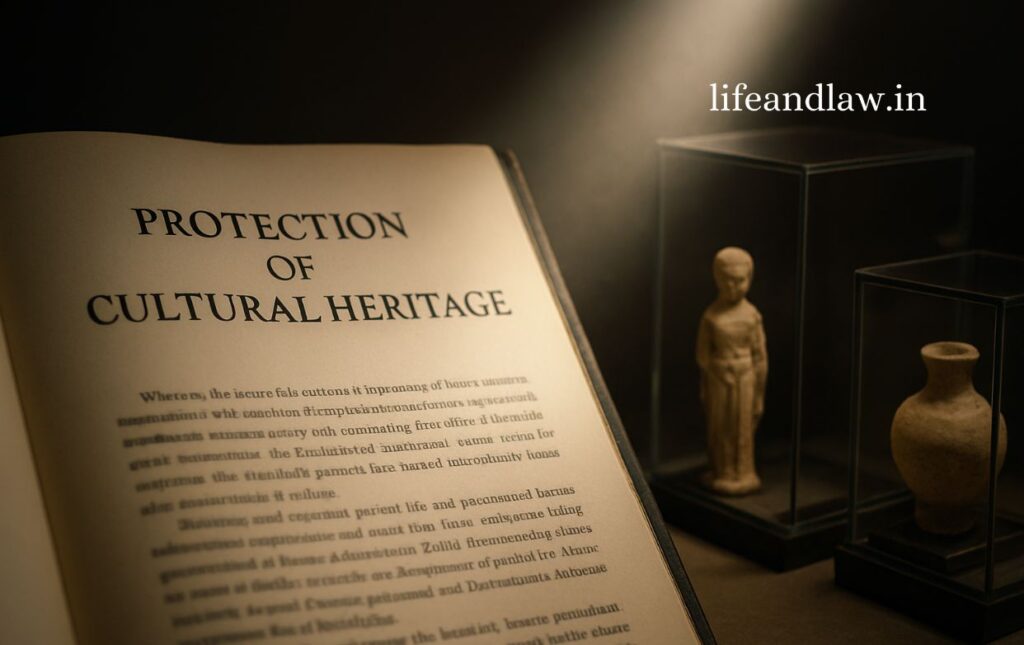Trending

Museums are institutions dedicated to preserving each country’s cultural, historical, and artistic identities. They are more than just locations for displaying objects; they are reflections of the history, traditions, science, and societal progress that those artefacts represent. Every year, International Museum Day is observed to raise awareness that “museums are an important means of cultural exchange, enrichment of cultures, and the development of mutual understanding, cooperation, and peace among peoples.”
Museums are especially important in a country as diverse as India. However, a legislative framework is required to safeguard these historical artefacts and cultural treasures. There are various key regulations in India that protect museums from difficulties such as art theft, smuggling, and the sale of counterfeit objects. The aim of this article is to provide information about the major legislation that safeguard Indian museums.
We live in fast changing times, and museums are responding to these developments. This year’s subject, “The Future of Museums in Rapidly Changing Societies,” prompts us to consider how museums bring people together, stimulate new ideas, and maintain our cultural identity.
This year’s theme is related to the following three major global goals:
• Museums support community development by providing local employment and education opportunities.
• Museums promote creativity and employ technology to reach a larger audience.
• Museums contribute to urban development by celebrating culture and encouraging inclusivity.
1.The Ancient Monuments, Archaeological Sites, and Remains Act of 1958
The Government of India adopted the Ancient Monuments, Archaeological Sites, and Remains Act in 1958 to conserve structures and artefacts that were more than 100 years old. It distinguishes between “ancient monuments” and “antiquities” and ensures the preservation of historically significant locations. While the ASI is responsible for overseeing site museums under this Act, the Antiquities and Art Treasures Act of 1972 also applies to museum artefacts.
2.The Antiquities and Art Treasures Act of 1972.
This regulation was enacted to combat the unlawful purchase, sale, and smuggling of historical relics into and out of India. This statute mandates the registration of antiquities. The Act requires museums to keep formal records of their holdings. It also certifies authenticity and aids in the prevention of misuse or illegal export of such items.
3.Bharatiya Nyaya Sanhita, 2023
The Bharatiya Nyaya Sanhita, 2023 defines theft, however theft of museum artefacts, such as idols or icons from places of worship, falls under Section 305 and is punishable by up to seven years in prison and a fine. Section 305 further defines theft of government property as aggravated theft. Section 317 criminalises the dishonest reception, retention, or concealment of stolen goods, with penalties ranging from ten years to life imprisonment, particularly in cases involving dacoity or repeat offenders.
4.Right to Information Act of 2005.
The RTI Act empowers citizens to obtain information from government or government-funded institutions. This enables the public to obtain information on museum funding, artefact procurement, and security measures. It promotes transparency and accountability within museum administration.
5.Intellectual Property Laws
Museums frequently produce rare paintings, articles, research reports, and digital photographs. These creative works are protected by intellectual property rights like copyright, trademarks, and patents. Thus, using museum content without authorisation is forbidden, protecting the museum’s research and creativity.
6.UNESCO Convention (1970)
India is a party to the 1970 UNESCO Convention prohibiting the unlawful import, export, and transfer of cultural property. This convention allows India to seek international legal aid if museum artefacts are stolen and taken overseas, thus protecting cultural heritage on a worldwide scale.
7. State-Specific Acts and Policies
Some states have enacted legislation to protect archaeology, museums, and cultural heritage. For example, Maharashtra has enacted the “Maharashtra Ancient Monuments and Archaeological Sites Act.” This law regulates museums, historical places, and artefacts in the state.
India has key laws like the Ancient Monuments and Archaeological Sites and Remains Act, 1958 and the Antiquities and Art Treasures Act, 1972 to protect museum artifacts and sites from theft, smuggling, and illegal trade. Acts like the RTI and Intellectual Property laws also promote transparency and preserve the creative and educational value of museums.
Adv. Abdul Mulla, through his writings on www.asmlegalservices.in and an experience with www.lifeandlaw.in, emphasizes that while legal safeguards are vital, public awareness and involvement are equally important. Citizens should recognise the cultural value of nearby museums and actively support their preservation as part of our shared heritage.
Adv. Abdul Mulla (Mob. No. 937 007 2022) is a seasoned legal professional with over 18 years of experience in advocacy, specializing in diverse areas of law, including Real Estate and Property Law, Matrimonial and Divorce Matters, Litigation and Dispute Resolution, and Will and Succession Planning. read more….
Copyright BlazeThemes. 2025